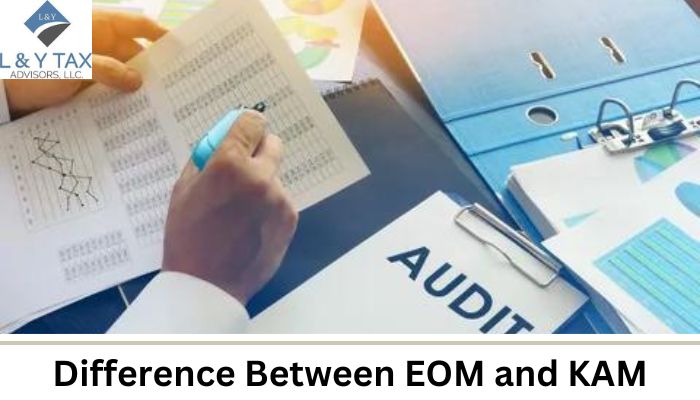
What is the Difference Between EOM and KAM?
The world of finances is stuffed with complex procedures and terminologies, such as ‘Emphasis of Matter’ (EOM) and ‘Key Audit Matter’ (KAM). Both are mandatory for ensuring monetary transparency in an audit report. But what is the difference between EOM and KAM?
Emphasis of Matter (EOM)
An Emphasis of Matter (EOM) is something the auditor thinks the reader should be aware of. However, it is not a matter of significance. An EOM is added to the report without changing the auditor’s assessment to offer further details or context.
Read about the IRS & state audit representation.
Key Features of EOM
Importance
EOMs draw attention to issues that are deemed vital. However, they are not always substantial to the financial accounts,
Auditor’s Judgment
The auditor’s professional judgment is the basis for including an EOM.
Communication
The audit report serves as a vehicle for informing shareholders about EOMs.
Disclosure
EOMs are revealed in the auditor’s report after the auditor’s opinion.
Key Audit Matters (KAM)
A topic that the auditor deems most important during the audit of the current period’s financial accounts is a Key Audit Matter (KAM). These factors are seen to be crucial in determining the auditor’s assessment of the financial accounts.
KAMs are an indication of the auditor’s expert opinion of the areas where the financial statements are most likely to be materially misrepresented.
Key Features of KAM
Importance
KAMs are intrinsically crucial to financial accounts and audits.
Auditor’s Judgment
The auditor uses their professional judgment to choose which KAMs to use.
Communication
The audit report shares KAMs with the audit committee rather than the shareholders.
Disclosure
The auditor’s report reveals KAMs, which offer information on the areas the auditor deemed most crucial throughout the audit.
What is the Difference Between EOM and KAM?
This table is the easiest guide to learn what is the difference between EOM and KAM:
| Features | Emphasis of Matter (EOM) | Key Audit Matter (KAM) |
| Objective | Highlights important matter for user understanding | Identifies most significant audit areas |
| Essentiality | Not mandatory | Mandatory for listed entities |
| Impact on opinion | No impact on opinion | No impact on opinion |
| Location in report | Separate paragraph before or after KAM section | Separate section after basis for opinion |
When to Choose EOM Over KAM?
The context and the amount of risk involved in the audit are usually the most important factors in deciding between EOM and KAM.
When the auditor wishes to point out something important that is already clearly stated in the financial records, such as a lawsuit that is still going on or the effects of a natural catastrophe on operations, EOM is usually the right choice. It is most beneficial when there is no qualification requirement or to stress the auditor’s judgment.
EOM is a clear technique to ensure everyone knows what is happening without causing much trouble for small organizations or low-risk audits. It gives stakeholders peace of mind that the problem, albeit serious, will not alter the audit opinions.
How Regulatory Bodies View EOM and KAM?
The PCAOB and IAASB are two regulatory agencies with different views on EOM and KAM reporting. KAMs are required for certain types of audits for public companies, whereas EOMs are mostly optional.
Regulators impose KAMs to make audit reports more useful for communication. This means that auditors have to explain decisions that significantly impacted the audit. This fits with the bigger aim of making audits more open and building trust among stakeholders.
On the other hand, EOMs are not meant to replace KAMs. They are intended to work with them in certain situations that exclude making judgments. Auditors can create reports fulfilling compliance and transparency requirements if they know how regulators rank these tools.
What is the Difference Between EOM and KAM in Audit?
An Emphasis of Matter (EOM) in an audit report brings attention to anything that was already mentioned in the financial records that the auditor assumes is important for the user to understand. It does not affect the auditor’s mind. EOM is not compulsory and the auditor can use it when they think it will help.
A Key Audit Matter (KAM) points out problems that needed extra auditor scrutiny during the current audit period. Many companies that are listed on the stock exchange must use KAM. It gives information about important decisions and hazards the auditor faced without changing the audit opinion.
How Do EOM and KAM Complement Transparency in Audit Reporting?
EOM and KAM work together to make audit reports simpler to understand.
EOM tells those who use financial statements of important disclosures that have previously been made, like uncertainties or contingencies. KAM gives you a better idea of what the auditor is looking at, how they make decisions, and how they deal with high-risk or difficult topics during the audit.
Both of these things assist make audits less of a “black box” by making the risks, assumptions, and reasons behind the auditor’s decisions more clear. This synergy makes users more sure of the audit procedure and enables them to better understand the fiscal statements of the organization.
Practical Implications for Financial Statement Users
Knowing the distinction between EOM and KAM is not only important for auditors. It is equally relevant for regulators, investors, and all other people who use financial statements. From the standpoint of a consumer, the EOM acts as a signal and alerts the reader to information that could influence interpretation, but it does not suggest a higher risk of audit. It assists readers in focusing on the context and not questioning the validity of the financial statements.
KAMs, however, give a deeper understanding of the audit in general. They pinpoint areas of significant judgment, complexity, or estimation uncertainties, allowing the user to see the areas where risk was concentrated throughout the audit. This transparency also supports informed decision-making and enhances confidence in the process of auditing. In combination, EOM and KAM enhance transparency by addressing the issues that auditors should pay attention to and where auditors devote the majority of their time.
Application of Auditing Standards for EOM and KAM
Standards on auditing provide specific guidance to auditors on when and where to include EOM/KAM paragraphs in an audit report. ISA 701, Communicating Key Audit Matters in the Independent Auditor’s Report, establishes the Requirements for identifying and communicating KAMS primarily for Listed Entities. This standard aims to provide transparency on the most important areas of audit matters and how they were addressed. This enhances the communicative power of the auditor’s report and promotes user comprehension.
ISA 706 (Revised) also addresses the use of Emphasis of Matter paragraphs, which guide auditors on when an EOM is necessary to highlight certain information that has been included in the financial statements. EOMs are to unambiguously indicate that the auditor’s opinion is not modified and cross-reference to related disclosures.
Taken together with those standards, these further standards promote the consistent application of EOM and KAM and assist users of financial statements to understand more clearly what has been audited.
Read more: What are the 7 audit procedures?
The Bottom Line
Financial statement users must comprehend what is the difference between EOM and KAM. The former provides more background information for the user, while the latter sheds light on the auditor’s areas of interest. With the above-explained details about EOm vs. KAM, financial statements, and the audit process, they can fully grasp these ideas.
Contact L&Y Tax Advisors, LLC. to streamline your taxation and financial matters.


